Edinburgh Student Surgical Society Exhibition
Posted by Cass Art on 21st Aug 2021
The Edinburgh student surgical society (ESSS) inaugural art competition initially began as a component of the 11th Annual Undergraduate Surgery & Trauma Conference. This was organised by (then) medical students/conference convenors Laura Clark and Katie Lowe and was set to take place in March 2020.
The conference theme, “Surgery - Out of the Operating Theatre”, was predominantly inspired by the collaboration of artist Dr Mark Gilbert and Professor Iain Hutchison (consultant maxillofacial surgeon) on the Saving Faces project. In keeping with this, delegates were invited to submit artworks related to surgery and medicine for judging and display at the conference.
After the conference was cancelled due to the Covid-19 pandemic, it was later decided by the convenors to replace the original competition with a larger, stand-alone one. Through this, ESSS aimed to encourage students to expand their skillsets and to explore their wider inspirations in advance of choosing their future career paths. We also wanted to highlight the vital role that art (and medical humanities) play in developing empathy and other key attributes essential to becoming well-rounded clinicians.
Entries were opened to all medical, biomedical and nursing students at the University of Edinburgh and the artworks were marked by an esteemed judging panel. This panel consisted of Dr Mark Gilbert (artist and associate professor of medical humanities), Mr Alastair Faulkner (prolific artist and orthopaedic surgeon) and Dr Gavin Francis (consultant GP and successful author; whose books you will see around the Blackwell’s store!). Prizes for the winners and the in-person exhibition space were then kindly donated by Cass Art.
ESSS would like to thank everyone who had a part in making this competition a success. This includes the talented entrants, the judges, Laura from Cass Art and you the viewer. We hope that you enjoy experiencing the fantastic submissions that we have had this year in person. A QR code on the poster can also be used to view all of the pieces collectively, via the online gallery. edsurgsoc.weebly.com/artexhibition
-Laura Clark, organiser and creator of promotional art work (Skeleton)
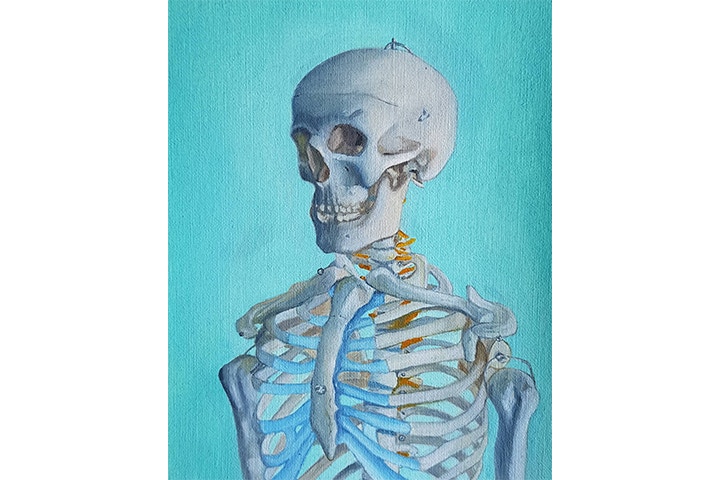
We were delighted to speak to the winners about their practice and winning works. Enjoy!
Natasha Maitland-Davies
Hello! Congratulations on submitting the winning piece for the ESSS competition. Could you introduce yourself and a bit about your studies?
I'm Natasha, I'm from North Wales and I'm in Edinburgh, going into my 4th year of Medicine. I've been drawing portraits for a long time and I'm glad I could keep up the hobby when I started university (even if it meant hauling all of my art supplies up to Edinburgh with me!). I think I like portraiture and realism partly because I enjoy the challenge of capturing a likeness and then trying to match exact shades and details.
It's a personal piece that I probably wouldn't have done had it not been for the competition. I decided to go for it because I thought it would be interesting to represent some slightly different anatomy. I've been wanting to do a self-portrait for a while too.
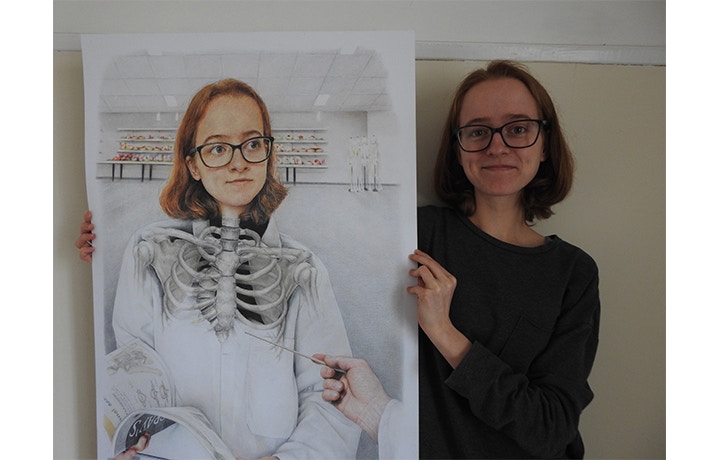
Is this the first time you have portrayed your scoliosis in your art? I saw you mentioned that it was inspired by an anatomy lesson, do you often get inspiration from your medical lessons for your work or are you normally focused on other subjects to draw?
It is the first time I’ve drawn anything with a medical or anatomical theme actually. I was excited to make a crossover between art and Medicine and I think it's something I want to do more of. It would be a nice way to take some of my learning and convert it to artwork, so that more people can come across medical conditions or anatomical differences that aren't often shown in art.
I've drawn quite a variety of people, but usually my niche is drawing actors as I love watching films and series. Sometimes I directly copy a photograph and other times I'm more creative. I have fun merging into one drawing the different characters played by the same actor.
The detail and realism in your piece is incredible, a lot of people have been commenting on it in our display here in Edinburgh. Could you take us through some techniques you use to get such accuracy and any go to materials you use?
Thank you very much! I use Faber Castell Polychromos and Prismacolour pencils for coloured drawings, on heavy card. I tend to start with lighter and brighter colours covering bigger areas, and then gradually I add darker colours and more detail. Layering lots of different tones takes a while but I think it adds a lot of depth.
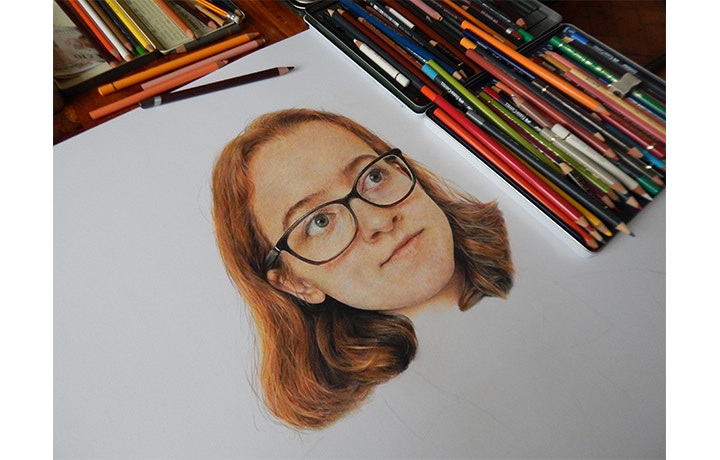
What did you enjoy most about creating this piece?
It was a great idea for the society to run the competition when I'm sure a lot of us wanted something a bit different to focus on! Working to the competition's theme and seeing how everyone else interpreted it was good fun. My favourite part of creating this piece was seeing it come together when I added in my skeleton and the background, and made the finishing touches!
Leigh Cui
Could you give us a little background on how you got in to paper cutting, your usual subject choices and any importance it has to you?
I’ve been making traditional paper cuttings for quite a few years now. I think I was around 12 or 13 when I attempted my first ever paper cutting. It was around Chinese New Year and in China it is traditional to decorate your home with paper cuttings of zodiac animals and characters such as luck and fortune. But in the UK, these decorations are expensive and hard to come by as they are only stocked by Chinese supermarkets and usually sell out very quickly. That was what inspired me to try making them myself. Since then, I have always made our Chinese New Year decorations and, now that I’m in university, I have been trying to teach my younger siblings so they can make them too.
My usual subject choices are very traditional since they are for festival decorations. I absolutely love the layers upon layers of intricate symbolism woven into these very traditional designs. A lot of my usual subjects such as zodiac animals, characters, and plants, revolve around the imagery of luck, blessing, and fortune for the coming year. And of course, traditionally the paper is red, which is one of the lucky colours in Chinese culture, thus adding another layer to the symbolism.
Chinese paper cutting is also a traditional gift in Chinese culture. Here in the UK, I love the uniqueness of this art style as a gift and as such I have often made designs to give away to friends for birthdays and engagements. These often depict plants, such as the plum blossom, and animals, such as magpies, which symbolise a wish of blessing and fortune upon the recipient of the gift. For me, the art of paper cutting holds a very special place in my heart. Since I was born in China and raised in the UK, at times I have felt distanced from the culture of my birth. But I feel learning the art of paper cutting has helped me to reconnect to my parent’s culture and experimenting with this style has helped me to forge my own connection to my family’s heritage.
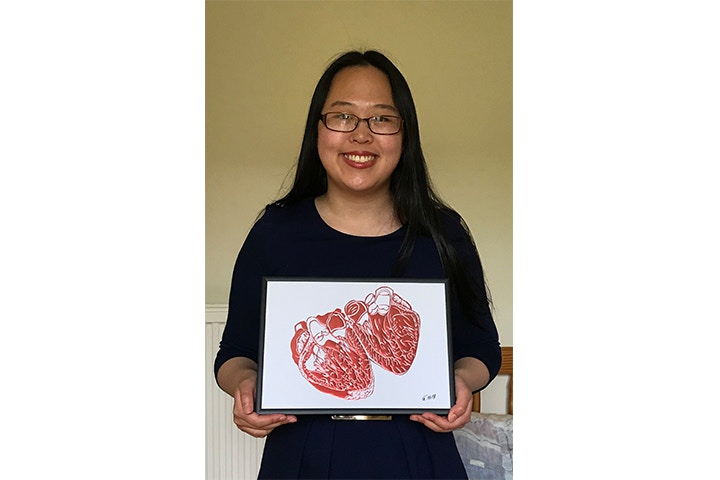
Was it your studies that inspired this piece and what made you choose the heart over another organ?
I am currently studying medicine at the University of Edinburgh. I was inspired to create this piece when I came across a beautiful illustration of the heart from Netter’s Atlas of Human Anatomy during my revision. I love using Netter’s for anatomy revision as all the illustrations are incredibly detailed masterpieces. The cross section of the heart was so complex and beautifully illustrated that I just had to use it as the basis of my paper cutting for this competition. When it comes to my artwork, I just love a challenge. This has probably been my most ambitious paper cutting design I’ve created to date because of all the tiny delicate details involved in an accurate depiction of the human heart, but I must admit creating it was a lot of fun and I do enjoy stepping out of my comfort zone and experimenting with different styles and subjects.
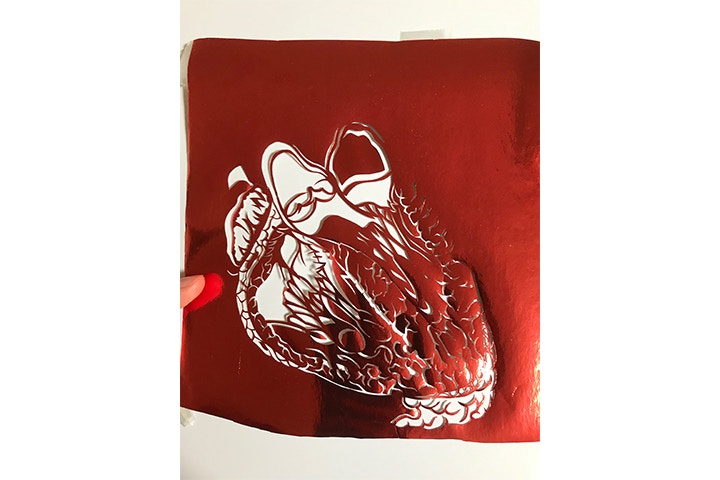
I know this past 16 months has affected people’s creativity differently, have you found your practice change through the pandemic while also studying?
I think studying medicine through the pandemic has not only helped me to better appreciate the importance of my studies but also opened my eyes to the challenges I may face in my future career working for the NHS. Living through this pandemic has been especially hard on everyone and it has been extremely challenging avoiding the dangers of burnout over this time.
I feel very fortunate that I was able to use my creative skills as a form of mindfulness, to de-stress and maintain my mental health during this extremely challenging time. Looking back, I realise that doing so has helped to reignite my passion for creativity which I had been neglecting over the past few years as I focused more on studying and research. Over the course of the pandemic, I have been branching out, exploring and experimenting with other areas of creativity outside of art, such as fantasy writing and sewing.
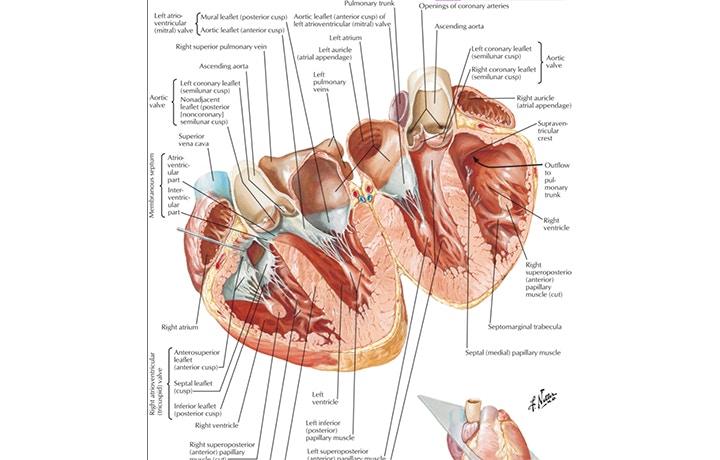
What are your key materials for creating these pieces? Do you have any favourite brands you like to use?
The key materials I use are a metallic-red wrapping paper, tracing paper, a sketchbook, an art knife, and a cutting mat. A pair of shar embroidery scissors can also be very helpful to some designs. I don’t really have a preferred brand for any of my materials, since I’m on a student budget I usually use more cost-effective brands or materials that are on offer. Currently most of my tools are from The Works. Since I am self-taught, I found my current technique through trial and error and include a few more steps than the professionals would. A lot of the professional pieces sold in China use red tissue paper as the preferred medium, but I am still not skilled enough to graduate to such a delicate material. Although saying this, I do love the sheen of a metallic wrapping paper that can catch the light and give the artwork another dimension when light hits it at just the right angle.
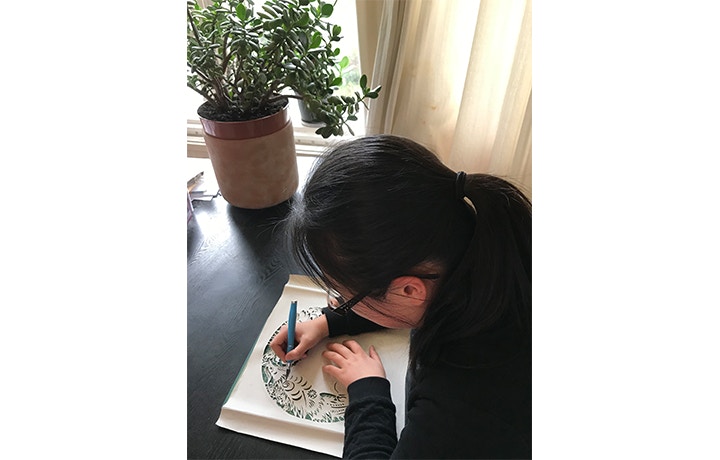
For anyone interested in taking up paper cutting, I would recommend starting with the materials I have listed above before moving on to more delicate materials. Wrapping paper is a nice sturdy material for complete beginners that is thick enough to cover any small mistakes and hesitation marks. Since wrapping paper has an obvious front and back, I usually sketch out my design in my sketchbook before transferring it back-to-front to the back of the wrapping paper via the tracing paper. This is to ensure that the design is the right way around when viewed from the front of the wrapping paper. If you are using a paper that is red on both sides or a symmetrical design, then you may skip out the steps involving the sketchbook and tracing paper as this is unnecessary. Then, simply cut out the design using either an art knife or sharp scissors, or both. I would recommend experimenting to see which tool you find the most comfortable and best suited to you.
Mallaika Viswanath
Hello! Thank you for taking the time to chat about your work and letting us display it in our shop. Could you introduce yourself a little, what is it you are studying within medicine?
Hi, I’m Mallaika and I’m about to start my 5th year of Medicine at the University Of Edinburgh. We study a bit of everything and so I’m not too sure about what I want to specialise in yet. However, I’m quite interested in emergency and trauma medicine and surgery – particularly reconstructive plastics.
You wrote that your piece was inspired by your recent struggles as a BAME woman in medicine. Art often serves as a platform to discuss important topics and your piece is a perfect example of that. Could you expand on the inspiration behind it?
This piece was inspired by a few different events that transpired this year, including my recent struggles as a BAME woman looking to set out on a career path for the future. The piece encapsulates the long-standing dilemma women in surgery face between deciding between their career or a family, which is represented by the classic symbol of fertility: the pomegranate. It ponders the unique quandary women find themselves in as they weigh up cultural, societal and personal expectations when contemplating their futures.
At the time of creating this piece, there was also a perturbing article in the Journal of Vascular surgery that vilified young female surgeons who wore bikinis or “inappropriate” clothing on their private social media profiles. The article was redacted after an understandable backlash and it provoked the #medbikini movement, with many female healthcare staff posting photos of themselves in bikinis to combat the notion of women’s clothing undermining their professional capabilities. This incident greatly inspired the message I wanted to portray with this piece. Women are often painted as dichotomous caricatures: the blonde, heavily made up "bimbo", or the bookish nerd, and denied the multifaceted personality that makes us wonderful, complex, and diverse beings. The blood red manicured nails of our mystery woman invokes an element of lust and speaks to the general everyday sexism women face, as they struggle to balance femininity and sexuality, whilst striving to be taken seriously as intelligent individuals in the patriarchal world of academia- both within medicine and without.
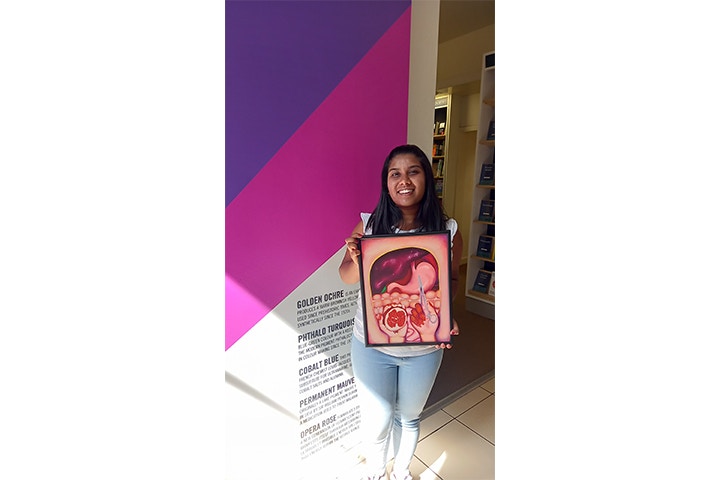
Have you always created your art digitally or did you start with traditional methods? What is it that draws you to this form of art?
This was actually the first time I’ve experimented with digital art! I’ve always been interested in it and after using Adobe Fresco to create a Visual abstract for a research competition, I just ran with the theme of digital medical art. I love using a variety of different media for my art but traditionally I find myself drawn to acrylic painting as I find it a very versatile medium but easier to control than watercolour. I believe art should not only be vibrant and eye catching but also have a message to convey, so I usually like to try and tell a story with my artwork. These have ranged from the ebola crisis, to African folklore (the tale of the Ddungu), to light hearted romantic landscapes in the style of Leonid Afremov.
Could you take us through the process of creating this piece? I’m fascinated by artists you can work this way, my tech skills leave a lot to be desired!
I used Adobe fresco on my tablet to draw this piece. I find it easier to sketch out the rough composition using the pencil tool and then block out the rough colours and shapes before refining the shading and details. Fresco allows you to create individual masked layers which meant I could revisit and edit individual aspects without affecting the rest of the piece- which is an advantage over using actual paints. One of the challenges in creating this piece however, was that it took time to get used to how the brushes and paint would flow on the digital canvas – something that’s a lot less predictable than the acrylics or watercolour I’m used to working with. Nonetheless, I really enjoyed the process of learning something new and look forward to creating more digital art pieces in the future.
You can learn more about the Edinburgh Student Surgical Society on their website here.


